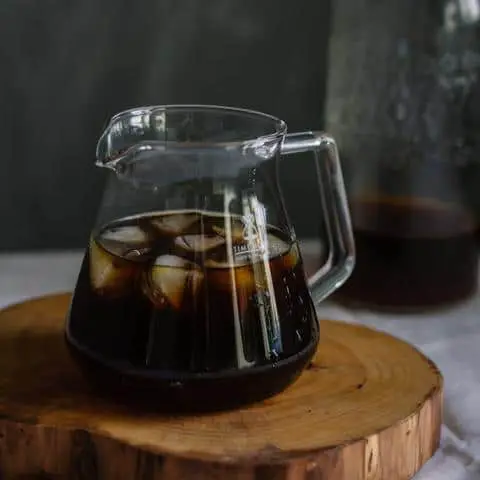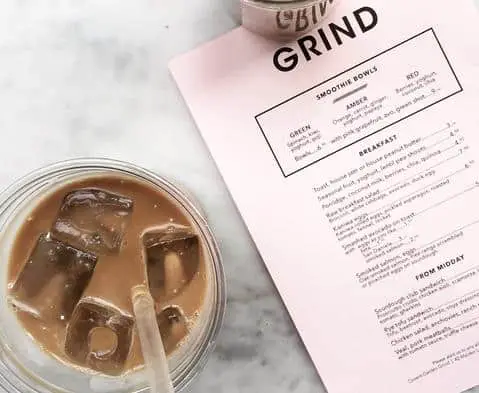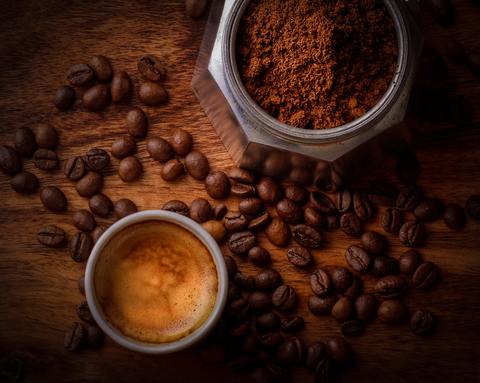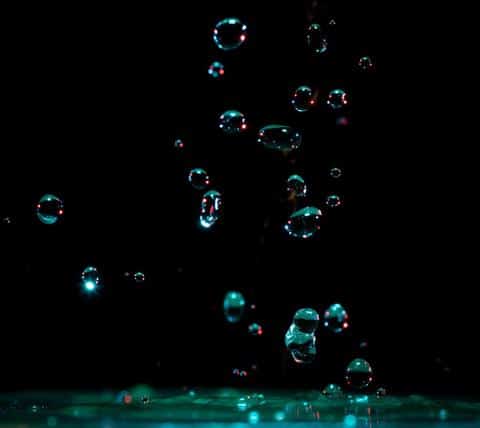Looking for in-depth information on cold brew coffee? Or are you just a coffee enthusiast looking to discover a new and exciting way to enjoy your daily cup of Joe? From boutique coffee shops in your neighborhood to the big leagues in Peets and Starbucks, cold brew coffee has rapidly become a mainstream commodity.

Sure, the idea of brewing coffee without hot water might initially sound weird- but once you’ve had a refreshing sip on a hot summer afternoon, you’re likely to jump ship like the rest of us. With this in mind, this comprehensive cold brew guide provides an overview of what cold brew coffee is, its benefits, multiple ways to brew it at home with different apparatuses, what is particularly special about nitro cold brew, and more!
For your information, if you click on a product on Jayarrcoffee.com and decide to buy it, we may earn a small commission.
Table of Contents
What is Cold Brew Coffee?
If you frequent cafes, it’s likely that you’ve come across cold brew coffee. But maybe instead you’ve only heard of iced coffee – or perhaps nitro coffee. What is the difference between these brews?
By definition, cold brew is ground coffee that is saturated in room temperature or cold water and allowed to sit (steep) for up to 24 hours. According to other sources, it could also refer to a beverage made by allowing cold water to gradually drip over a bed of coffee grounds. It’s also worth noting that the New Orleans version of cold brew includes chicory in the coffee grounds.
Cold brew coffee should not be confused with iced coffee, which is regular hot coffee that is allowed to cool and then poured over ice. The two techniques yield significantly different results at the molecular level.

If the idea of using cold water or serving coffee with ice is perplexing, wait until you experience nitro coffee! Simply put, it’s cold brew coffee with a dash of nitrogen- more on this later!
The Antiquated Origins of a Modern Treat
The first true cold brew, i.e. using cold or room temperature water to brew coffee is usually traced back to Japan in the 16-1700’s. The recipe and method of making coffee this way is believed to have been introduced by Dutch traders, who would have brewed coffee in a similar way to allow it to be a sea-worthy beverage. The cold or “Dutch” style of brewing coffee allowed the drink to be stored for much longer. Usually Kyoto is honored as the birthplace of “true cold brew”.
Coffee Trends – The Cold Brew Craze
Cold brew coffee has experienced an unprecedented surge in popularity over the last couple of years. According to the most recent National Coffee Data Trends (NCDT) by the U.S. National Coffee Association, awareness of cold brew coffee is as high as 80%.

The industry trends also show that consumers are paying more attention to how what they eat and drink is made than ever before. This emerging consumer pattern is driven by a growing demographic of young coffee drinkers embracing both innovation and transparency from ingredients to preparation methods used for the end products they consume. So, how does the cold brew craze fit within that paradigm? Which unique traits does it offer to an increasingly discerning market?
5 Advantages of Cold Brew Coffee
Flavor Profile: Aside from the characteristics of coffee beans, there are two main factors that affect coffee flavor: 1) brewing temperature and 2) time.
Although hot water (91-96 degrees Celsius) facilitates a rapid extraction of flavorful compounds, it also causes natural coffee oils and acids to oxidize and degrade faster, leading to bitterness and acidity. In contrast, cold brewing relies on time to extract the soluble flavor compounds – but not the acids and oils. Consequently, you can use cold brewing to brew a coffee concentrate that is still drinkable and not bitter.
Overall, cold brewing provides a smooth, heavier body that is a treat to your palate.

Drink Versatility: Do you love to experiment? The drink variations using cold brew are myriad. While most people just add milk, you can add spirits (a caffeinated cocktail!), or even lemonade! A popular addition is nitrogen – more on this later!
Convenience: In our fast-paced society, most people don’t have time to enjoy coffee in a cafe – or even prepare a cup at home! With cold brew coffee, you can prepare a concentrated batch over the weekend and leave it hanging out in your refrigerator for consumption throughout the week. Simply dilute the concentrate and rush off to work! Cold brew coffee can generally last for up to 10 days refrigerated.
Easy to Brew and Inexpensive: Many coffee making apparatuses are somewhat inaccessible and expensive for your average coffee drinker. However, the materials for making cold brew are available in most stores – and with the help of a simple DIY recipe, even a novice can prepare a batch.

Health Benefits: The low acidity of cold brew coffee makes it ideal for coffee lovers with gastrointestinal issues.
Are you convinced? Want to take cold brew coffee out for a spin? While you can easily find cold brew coffee at Starbucks, Peets, or your local independent coffee shop, it’s often more expensive than a regular cup of coffee. The reason is that, unlike hot coffee, cold brew takes a lot of pre-planning – you can’t just run to the back of the store and brew a fresh pot in a few minutes (it takes several hours for the coffee to steep).
Luckily, you can easily produce cold brew at home with inexpensive equipment. Read on to find out how!
Cold Brew Coffee Brewing Techniques – The Immersion Method
As with traditional “hot” brewing, there are several methods for making cold brew coffee – each with different outcomes in terms of mouthfeel, acidity levels, and flavor. These brewing styles include the Japanese Iced Method, the Ice Drip Method, and the Immersion Method. The choice between these cold brew techniques often depends on the desired flavors, acidity level, brewing quantity, and steeping period.
This article will specifically focus on the Immersion Brewing Method due to its wide applicability and superior popularity – not to take anything away from the other brewing techniques! The process involves placing a mixture of grounded coffee and cold water into a reservoir and allowing the combination to steep. Over a couple of hours, the coffee solubles are extracted and filtered out to create a smooth and refreshing drink.
Pros of Immersion Cold Brew
- Simplicity: How hard can putting ground coffee and water in a vat and letting it sit for a few hours be? You don’t need heat or complex and expensive equipment – just time. And when your batch is ready, you’re set for the week.
- Consistency: Replicating recipes and making adjustments is relatively simple when using the Immersion Method.
- Balanced Flavor: Not too acidic, not too bitter – but flavorful enough. The complete saturation of the grounded coffee using the Immersion Method facilitates a great mouthfeel and a full-bodied cup, with lower flavor notes (brown sugar, floral, fruity, caramel, etc.).
Cons of Immersion Cold Brew
- It Takes Time: From allowing the coffee to steep to the time it takes to clean the equipment, Immersion cold brew is time intensive.
- Jumbled Flavor: While you’re probably glad that the bitter flavors aren’t extracted, unfortunately, the same applies to bright and pleasant flavors that characterize some specialty coffees.
- You Need More Coffee: In comparison to hot coffee or some of the other cold brew techniques, the Immersion Method uses more ground coffee.
How to Make Cold Brew Coffee at Home – Equipment and DIY Recipes
Ready to brew your first batch of cold brew coffee? The first step in this exciting journey is finding the right equipment. Although there are several options when it comes to Immersion cold brew, they all have one thing in common – they are surprisingly affordable. Below are some of ‘cold brew makers’ you can use:
The Classic Toddy/Filtron Cold Brew System
Such is the popularity of the Toddy coffee maker that some people use the term ‘toddy’ as an alternative name for cold brew coffee. The system consists of a plastic brewing container placed over a glass decanter with these two components separated by a rubber cork and a reusable filter.
This brewing system is tried & tested, easy to use (practically foolproof!), great for batch recipes, and the replacement parts are relatively easy to find.
Ingredients
- Cold water
- Ground coffee (coarse)
- Toddy cold brew system
Instructions
- Place the ground coffee in a filter bag.
- Fill the plastic container with cold water (or room temperature) – maintain an average coffee-to-water ratio of 1:6.
- Secure the rubber cork and filter before placing the container over the glass decanter.
- Allow the coffee to steep for little over 17 hours.
- Filters the brew and store it in a refrigerator.
- Enjoy!
Coffee Sock
While Toddy and Filtron are veteran players with a significant imprint on the cold brew market, newcomers are now here to compete for a share of the pie. Case in point, the CoffeeSock- an organic cotton filter (sock) that is filled with ground coffee and allowed to steep in a mason jar full of water.
Aside from the eye-catching look of the container, The CoffeeSock is rather cheap, environmentally friendly, and easy to store. The only setback is probably the time and effort it takes to clean out the coffee grounds from the filter. We wrote about it more extensively here.
Ingredients
- Ground coffee (coarse)
- Cold water
- Coffee sock filter
- Mason jar
Instructions
- Secure the coffee sock around the mouth of the mason jar before pouring ground coffee into the filter.
- Cover the coffee grounds with a small amount of water and allow to bloom for a minute.
- Fill a mason jar with water – following the recommended coffee-to-water ratio of 1:15.
- Tie the open end of the coffee sock filter. This prevents leakages and similar accidents during the process.
- Let the coffee steep for up to 24 hours.
French Press
How about repurposing your existing coffee making equipment? We all know that a French Press is great for brewing hot coffee – but it also works just fine on the opposite side of the spectrum. It’s included in this list due to its widespread use as a cold brew device.
Whether it’s cold brew coffee on a sunny summer afternoon or a steaming cup on a freezing winter morning, a French Press has you covered. Well, unless you want a large batch size (can only brew about 1 liter).
Ingredients
- Ground coffee
- Cold water
- A French Press
Instructions
- Pour the ground coffee into the French Press.
- Add some water to saturate the coffee and allow the mixture to bloom for 60 seconds.
- Add more water in a coffee-to-water ratio of 1:8 and close the carafe, taking care not to press the plunger.
- Allow the coffee to steep for a little over 13 hours.
- Now press the plunger and pour the brew into a storage container.
Homemade Equipment
If you don’t have any of the equipment highlighted above, all is not lost! You can still pull off a MacGyver-Esque trick by using basic equipment lying around in your house. Start by looking for any container or vessel that is hygienic and can hold a liquid. You’ll also need some sort of DIY filter- cloth from a pillowcase or a sock (clean, of course), a fine mesh filter, or cheesecloth.
Ingredients
- Coffee beans (coarse ground)
- DIY filter (cheesecloth, fine-mesh sieve, paper filter, etc.)
- Container (e.g. a mason jar)
- Cold water
Instructions
- Organize your coffee and water in a ratio of 1:5.
- Mix the water and ground coffee in a container.
- Stir the mixture and allow it to steep for around 15 hours.
- Strain the coffee into a clean jar using your DIY filter.
- Store in a fridge and enjoy!
Selecting Roast Level for Cold Brew

Let’s initially consider level of roast for cold brew. This necessarily ends up being personal preference, but lets consider some of the features of light roasts vs. dark roasts:
Light roasts generally:
- Have complex flavors, often fruity and light maintaining characteristics of the original bean
- Light body due to the beans not having been roasted long enough to produce more oils or caramelized sugars.
- Usually more acidic.
Dark roasts generally:
- Have a sweet and rich flavor; the roasting process takes center stage as origin flavors are superseded by the roasting technique.
- The roasting process makes dark roasts oilier, and taking on bittersweet, chocolaty and even toasty flavors.
- Have a rich body and bold texture.
- Usually less acidic
While many argue that cold brewing light roasts results in a more balanced flavor due to the reduction in acidity resulting from cold brewing, many of the subtle flavors and the lighter body of the light roast are less pronounced. Thus, there is somewhat of a tradeoff between acidity balance and pronounced flavor when selecting a lighter roast.
Meanwhile, cold brews tend to already be rich with a robust texture, with an almost chocolatey, sweet flavor; dark roasts synergize with this flavor profile. The thicker and richer oils and textures make dark roasts a popular choice.
You can’t really go wrong with single origin, medium to dark roasted beans, and a couple popular favorites are Guatemalan and Kenyan. Some retailers do offer beans specifically roasted and blended for cold brew, so that could be an option worth considering if available. In general, its worth trying a variety of different options to find your coffee preference for cold brew.
The size of grind may be the most important factor when selecting coffee for cold brew. You want to use coarse ground beans, about the size of raw sugar or sea salt.
What’s Special About Nitro Cold Brew?
Nitro coffee is sometimes referred to as “cold brew nitro”. As implied by the name, the coffee is cold brewed and infused with nitrogen.
This may sound strange, but putting gas in beverages is actually pretty common. Cold beverages are filled with gas on a regular basis. Carbon dioxide gas is what makes soda so bubbly, though the term we use for this is “carbonated”.

Nitrogen is regularly found in a number of beers, as well. For example, Guinness calls their stouts “nitrogenated” and a number of nitro beers contain dark coffee flavors as well.
At some point, someone realized that Guinness’s creamy texture would make or a great cold brew. Nitrogenated coffee – much like some beers – is available only on tap. Cold-brew coffee that has been nitrogen-infused is released via a tiny pressurized valve in order to produce a creamy result.
What’s the Flavor Like?
Nitrogen-infused coffee has low acidity and is quite smooth. Best of all, it boasts a silky mouth feel. In the world of specialty coffee, it is quickly becoming the favorite drink of many java lovers.
The reason? Nitrogen gas isn’t water soluble, nor will it dissolve in carbon dioxide. As such, the bubbles found in the beverages infused with nitrogen are significantly smaller.

People who enjoy nitro-infused coffee prefer it black and typically have it poured over ice (or straight-up). They prefer the product to be naturally creamy, as opposed to making it creamy with dairy products. For people who enjoy sweets, several cafes serve it with vanilla syrup or sweet cream.
At Mighty Brew Bros, a coffee shop in Manhattan, nitrogen-infused coffee is even inserted into cocktails (can you say “nitrogen pina colada”?). It’s also paired with ice cream (vanilla) to produce nitro floats. Josh Kim, the owner, says that nitrogen-infused coffee is compatible with tons of flavors, as opposed to other types of coffee.
Nitrogen Cold Brew’s Special Look
Several shops sell and market nitro-generated coffee based on the drink’s visual appeal. Once it’s poured out of the tap, a cascade of shooting bubbles is produced, creating an exciting appearance.

This cascading effect – as displayed by nitro beers too – occurs because the bubbles are small enough to bounce off glass from the pressure of a flowing liquid.
Nitro Coffee: Potentially Healthier?
Coffee that is nitrogen-infused is marketed as a healthy alternative to conventional coffee. Several high-end fitness facilities now offer the drink to members on tap.
Instead of adding CO2 fizz, though, the pop of nitrogen is apparent in taste. This is where nitro coffee’s health credentials come into play. Compared to other coffee drinks, sugar isn’t added to nitro to make it taste better.
For those who are used to adding sugar and calorie-rich cream to their morning coffee, consider switching to nitro coffee instead to avoid consuming all that sugar. Some say it’s a transition to black coffee (low-calorie) without any compromise in taste.
Nitro coffee’s caffeine content is rather high (in contrast to standard coffee) since it doesn’t contain as much water. This makes it the perfect drink to amp yourself up before working out.

As with any cold brew, nitro coffee has low acidity. This is music to the ears of every coffee connoisseur with a sensitive stomach, as well as those who are susceptible to acid reflux.
Bonus Tips to Enrich Your Cold Brew Experience
If made right, cold brew coffee is simply divine. While brewing a batch is rather straightforward, there a few tips to enrich your experience and avoid rookie mistakes.
- The Type of Water Matters: It’s shocking that a staggering number of baristas and coffee enthusiasts are choosy with their coffee beans but oblivious to the water source. Considering the fact that water accounts for the largest portion of your cup, it’s only fair that you give the ingredient the attention it deserves. We have a guide here about preparing great water for coffee.
- Always Use Fresh Coffee: Know how your apple changes color from white to brown gradually? This is due to a process known as oxidation – and it also happens to roasted coffee. Over time, ground coffee loses its flavor and becomes stale or dull. This is why it’s important to use a fresh batch of coffee.
- Use a Coarse Grind Size: Unless you want to end up with a bitter coffee due to over-extraction, you should always use very coarsely ground coffee grounds when cold brewing.
- Shelf-Life of Cold Brew Coffee: Although several sources suggest that cold brew coffee takes up to 10 days in a fridge before it gets dull, try to consume it within a week.
- Caffeine Content: Looking for an extra kick in your cup of Joe? Unfortunately, cold brew coffee doesn’t necessarily have a higher caffeine content than regular coffee. On one hand, cold brew coffee is made with a higher coffee-to-water ratio which would increase caffeine content. However, hot water extracts more caffeine from coffee beans than the “cold” (or room-temperature) water used for cold brew.
